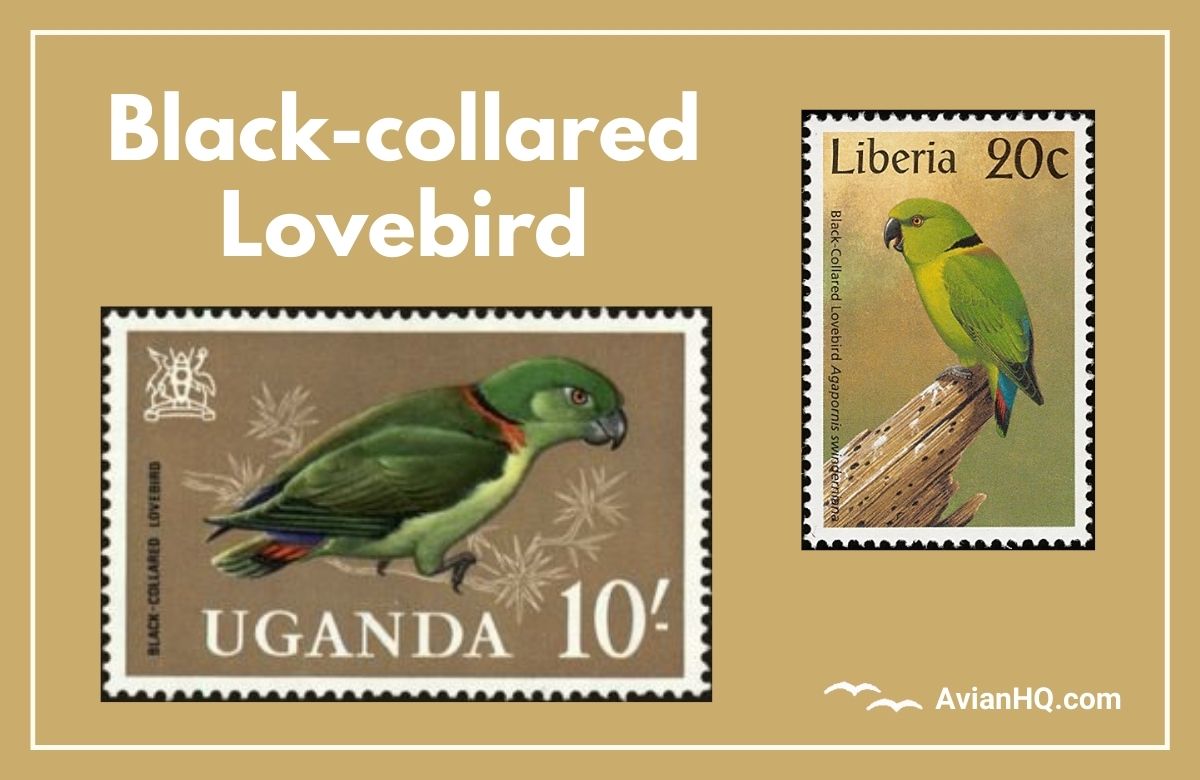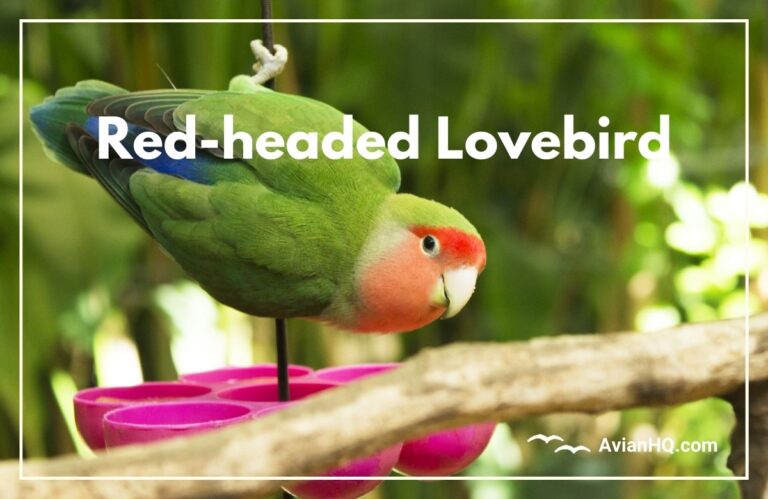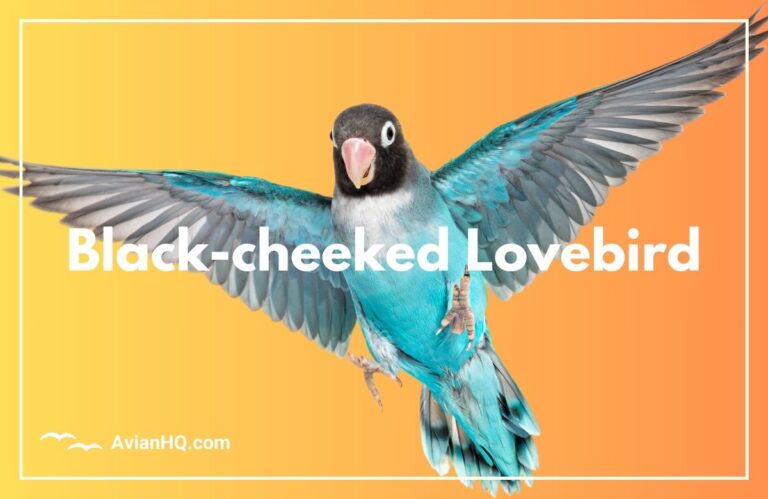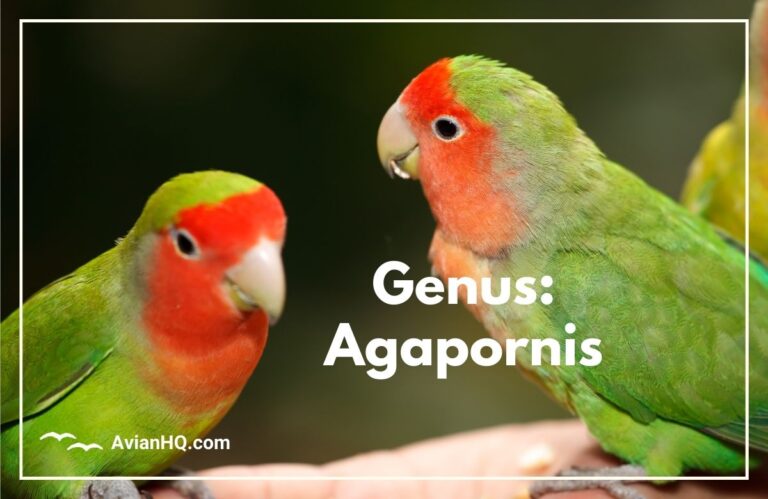Black-collared Lovebird (Agapornis swindernianus)
The Black-collared Lovebird is a small, colorful parrot native to the rainforests of equatorial Africa. With vibrant green feathers accented by a black half-collar and red-brown chest, this lovebird species has a striking appearance.
Weighing only 1.3 to 1.4 ounces (39 to 40 grams) and reaching just 5 inches (13 centimeters) in length, the Black-collared Lovebird belongs to the genus Agapornis. It is similar in size and shape to other lovebirds popular as pets, like the Peach-faced Lovebird. But unlike its better-known cousins, the Black-collared Lovebird remains relatively rare in aviculture and little-known outside its native habitat.
In the wild, these small parrots live in flocks up to 20 strong, foraging for fruit and figs high in the rainforest canopy in West and Central Africa. Shy and easily startled, Black-collared Lovebirds hide in the upper branches of tall trees.
While not considered threatened, their secluded forest niche and specialized diet make Black-collared Lovebirds challenging to maintain in captivity. Only a few breeders have succeeded in meeting these birds’ needs.
To the indigenous peoples of equatorial Africa, however, Black-collared Lovebirds are a more familiar sight. The birds still occur across much of their historic range, though habitat loss puts pressure on some populations. Understanding the natural history and conservation status of Africa’s green lovebirds can support both their survival in the wild and success in human care.
History and Taxonomy
The Black-collared Lovebird was first classified by German naturalist Heinrich Kuhl in 1820. Kuhl likely encountered the small parrots while collecting zoological specimens in Africa and brought back samples to Europe. He named the new species Agapornis swindernianus to honor Theodore van Swinderen, a Dutch professor at the University of Groningen.
Today taxonomists recognize three subspecies of A. swindernianus:
- Nominate Black-collared Lovebird (A. s. swindernianus): The nominate subspecies identified by Kuhl ranges across Liberia, Ivory Coast, and Ghana in West Africa.
- Cameroon Black-collared Lovebird (A. s. zenkeri): Slightly larger on average than the nominate form, this subspecies inhabits rainforests from southern Cameroon to Gabon and the Congo region.
- Ituri or Emin’s Black-collared Lovebird (A. s. emini): This Central Africa regional type ranges in forested areas of the Democratic Republic of the Congo and western Uganda.
The three subspecies differ slightly in the color and extent of the reddish-brown plumage on the neck and upper chest. But all represent the same species of vibrant little parrot adept at climbing and camouflage in the lush rainforest environment.
Physical Appearance
The Black-collared Lovebird derives its name from the most distinctive feature of its appearance—a narrow black band circling the nape and upper neck. This half “collar” stands out sharply against the small parrot’s otherwise bright green plumage.
Beyond the nape, the head and body feathers are a rich leafy green above. The lower back grades into sky blue, while the rump patch flaunts vivid red and blue. The short rounded tail also shows red at the base when spread.
The lovebird’s chest sports a brownish red bib, widest and most intense in the Cameroon subspecies. Legs and feet are gray, typical for arboreal parrots that climb through branches.
The Black-collared Lovebird’s stocky bill matches the color of its legs, ranging from gray to blackish horns depending on age and subspecies. Distinctive yellow irises glow within an eye-ring of small white feathers, which form a slight “spectacle” pattern.
Like all lovebirds, A. swindernianus displays minimal differences between the sexes.
Size and Weight
Length: approximately 5 inches (13 cm)
Weight: roughly 1.3 to 1.4 ounces (39 to 40 g)
Wingspan: about 6.5 inches (16.5 cm)
Differences Between Subspecies
The three recognized subspecies vary subtly in the extent of reddish-brown coloration on the neck and upper chest:
- Nominate (A. s. swindernianus): narrow black collar; dull yellow neck below
- Cameroon (A. s. zenkeri): more extensive rufous neck below collar
- Ituri / Emin’s (A. s. emini): intermediate red-brown color between the others
Juveniles of all subspecies lack the signature black nape collar, showing a patchy gray bill and brown irises until their first molt to adult plumage.
Habitat and Distribution
The Black-collared Lovebird inhabits a wide swath of equatorial Africa, centered on the dense rainforests of the Congo River basin. Its native range stretches from Ghana in the west to Uganda in the east, spanning the forests of Central African countries like Cameroon, Gabon, and the Democratic Republic of Congo.
Within this expanse, Black-collared Lovebirds stick to warm, humid lowland rainforests up to elevations of roughly 6,000 feet (1,800 meters). The birds favor primary forest with tall stands of trees, but also forage in secondary growth and cultivated groves near forest edges.
True to their shy nature, Black-collared Lovebirds position their nests high in the secluded upper canopy of the rainforest interior. They typically hide nearly 100 feet (30 meters) or more above ground.
Outside their native habitat, introduced populations are unknown for this reclusive species. Avicultural breeding successes remain limited. So sightings of the vibrant Black-collared Lovebird continue to occur exclusively within its historic African range.
Here the birds mingle and forage amidst other African endemics like barbets, turacos, and hornbills—species dependent on the same threatened rainforest habitat. Monitoring ecosystem health here is key for the conservation of A. swindernianus and its forest-bound neighbors.
Diet and Feeding
The Black-collared Lovebird shows adaptations in its beak shape and feet that reflect a diet centered on two rainforest staples: fruit and seed. Its sturdy horns allow the extraction of large hard seeds, while the grasping toes assist in plucking ripe fruits.
This lovebird’s favorite food in the wild is native figs. The birds use their scissor-like bill to snip open figs and access the seeds within. They also consume the fleshy fig fruits surrounding the seeds.
Beyond figs, Black-collared Lovebirds supplement with other rainforest fruits and berries in season, such as Rauwolfia, Harungana, and Macaranga. The small parrots additionally eat cultivated fruits like apples when gardens adjoin their forest habitat.
Small nutritious seeds round out the diet. As with fig seeds, this lovebird cracks open the hard outer coatings of various large forest seeds with its hawk-like bill. The birds also forage for cereal crops like millet and maize at plantation field edges.
Another key component of the feeding ecology of Black-collared Lovebirds is insects and insect larvae. The parrots excavate these from decaying wood and raid arboreal nests of social species. This high-protein addition likely helps sustain the lovebirds during breeding season.
Feeding Behaviors
- Forages in small flocks of up to 20 individuals
- Concentrates feeding in upper canopy of tall rainforest trees
- Returns regularly to favorite communal roost sites near reliable food sources
The niche requirements and feeding behaviors of the Black-collared Lovebird make it a specialist exquisitely adapted to its threatened arboreal habitat.
Breeding and Reproduction
Many details around the breeding biology of Black-collared Lovebirds remain scarce due to the challenges of studying these shy canopy-dwellers. But some observations help sketch the reproduction profile of Agapornis swindernianus.
This monogamous species shows preferences for two nesting strategies suited to life in the upper rainforest:
Nest Sites
- Tree hollows formed by decay fungi and insects
- Arboreal termite mounds constructed around living tree branches
Both provide the protective enclosure needed for vulnerable lovebird chicks. And both allow the adult pair access to fruit and seed resources nearby to provision young.
Clutch statistics show similarities to other lovebird relatives:
Clutch Size
- Typical clutch: 3 to 6 white eggs
- Likely two broods per year in peak seasons
Time from egg-laying to independence also mirrors lovebird development:
Incubation
- Starts with completion of clutch; done solely by female
- Incubation duration: 23 days
Fledging
- Chicks fledge at around 6 weeks
- Fed by parents for additional 2 weeks after leaving the nest
With Black-collared Lovebird pairs likely able to produce two clutches annually, their reproductive output appears on par with better-known lovebird species. This bodes well for population stability given adequate mature forest habitat.
Behavior and Ecology
The behavior of the Black-collared Lovebird centers around two ecological imperatives: finding food and avoiding predators. Several distinctive behaviors serve these ends.
Flock Sizes
- Forages in small groups of up to 20 birds
- Larger gatherings may form temporarily at abundant fruit trees
Feeding in small parties aids detection of food sources while minimizing competition. And the multiple sets of eyes and ears in a flock boost vigilance against the many rainforest predators of small parrots.
Roosting
- Roost communally each night in traditional sites
- May gather from wider area, up to 65 feet (20 meters) across
- Preferred roost trees offer cavities or dense foliage
By gathering at traditional nocturnal roosts, groups can locate reliable food spots the next morning. And communal roosting provides shared security while the birds rest.
Foraging and Feeding
- Feeding activities concentrated early morning and late afternoon
- Devote midday to rest and preening under canopy cover
- Call quietly while foraging so as not to attract predators
This pattern of dawn and dusk feeding maximizes feeding time while minimizing exposure during highest-risk mid day hours.
Interactions with Other Species
- Flocks are shy and retreat from disturbances
- Unknown if compete with other canopy frugivores
- Subject to nest predation and loss of habitat from logging
Overall the Black-collared Lovebird has evolved to judiciously exploit rainforest resources while keeping risk from threats at bay. But human impacts now endanger this delicate balance.
Conservation Status
The Black-collared Lovebird scores a category of Least Concern on the IUCN Red List of Threatened Species. But while still relatively widespread across Central Africa, the species faces growing threats in parts of its range.
Much of the difficulty in assessing A. swindernianus stems from its remote forest habitat. Researchers lack concrete data on total population sizes or trends across the region. Combined with the lovebird’s shy, quiet nature that keeps it hidden in rainforest canopies, quantifying its true abundance is problematic.
Broad habitat decline poses the major concern looking ahead. Rampant deforestation for timber, agriculture, and settlements continues eating away at Africa’s humid forests. Estimates suggest over 50% of the Congo rainforest has vanished in the past half century alone. And the fragmentation places both pressure and isolation on specialist bird residents like the Black-collared Lovebird.
Legal Protection
- CITES Appendix II species
- Legally protected from export in Cameroon and Gabon
- Losing safe habitat is still the main threat
While not yet endangered, the outlook in coming decades will depend on protecting intact rainforest ecosystems that sustain the Black-collared Lovebird and its niche. Loss of either food sources or nest sites could quickly deteriorate populations of this sensitive canopy forager across Central Africa.
Cultural Significance
For most indigenous forest-dwelling peoples of Central Africa, the Black-collared Lovebird blends into the backdrop of biodiversity making a living unseen in the rainforest canopy.
The birds occur from Ghana to Uganda across the Congo Basin—home to over 75 million rural inhabitants who depend directly on hunting and gathering from the surrounding forests. But the shy green lovebirds remain out of reach and out of sight from most people on the ground.
In rural villages nearest to intact rainforest, however, sharp-eyed resident children may spot Black-collared Lovebird pairs swooping through small forest clearings. And their musical chattering calls sometimes filter down from the high branches during active periods.
But overall the African lovebird occupies more space in the biological niche fabric upholding the rainforest ecosystem than it does in the cultural fabric of forest-dependent peoples. For the rural farmers of Cameroon, Gabon, and Congo, concerns center more on the game animals, fish, fruits, and seeds that directly sustain their families.
The conservation of showy mammals like forest elephants and gorillas draws more attention from ecotourists as well. Yet the plants and critters forming essential links in the broader food web—like the Black-collared Lovebird—also merit attention for their roles. Losing such pieces could destabilize entire habitats.
So while not a prominent cultural icon itself, Agapornis swindernianus forms one colorful stitch in the tapestry of biodiversity that underpins both forest ecosystem health and local human ways of life. Saving the rainforests ultimately supports both.
Conclusion
The Black-collared Lovebird makes up in vibrant color what it lacks in stature. This petite African parrot, distinguished by its namesake black neck ring, leads a quiet existence high in rainforest canopies across the Congo River basin.
Filling an important niche as a fig and fruit specialist, Agapornis swindernianus relies wholly on mature humid forest to meet its needs. As with other shade-loving wildlife, deforestation spells trouble for the Black-collared Lovebird by removing both food and nesting sites it depends upon.
While not a threatened species yet, steady habitat loss puts increasing pressure on its long-term outlook. And its specialized needs make captive breeding a challenge. Safeguarding tracts of intact primary rainforest across Central Africa is thus crucial for the future of this beautiful little parrot.
As a product of millions of years spent adapting to the unique conditions of Earth’s second largest rainforest, the Black-collared Lovebird serves as a barometer for the health of an entire ecosystem. Working to conserve A. swindernianus means ensuring the survival of Africa’s magnificent forests themselves.
In protecting such vibrant and vulnerable species, we ultimately invest in our own future too. Their fates remain intertwined with the fate of the global climate and human communities relying on tropical forests worldwide. It is a small but vital bond linking us to a diminutive green parrot on another continent.







